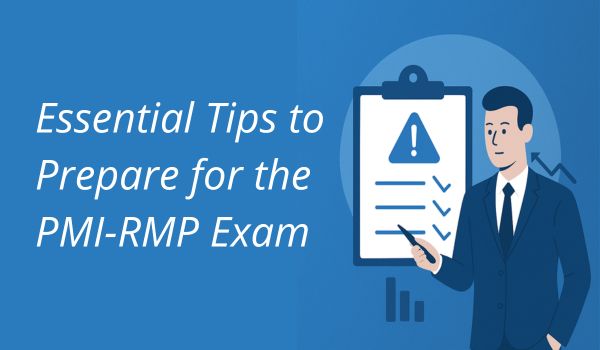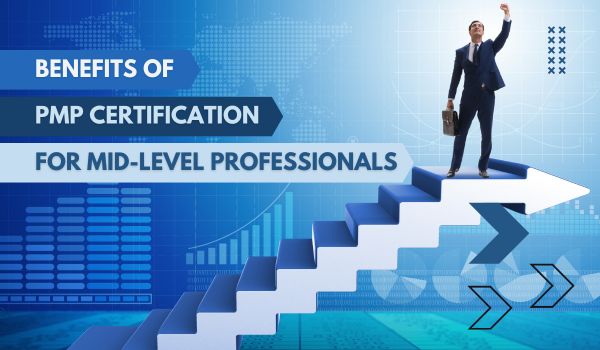The PMI-RMP® Certification (Risk Management Professional Certification) is one of the most valued credentials for project managers who want to specialize in risk management. It validates your ability to identify, assess, and mitigate risks in line with PMI standards, which makes you an asset in high-stakes projects.
With over two decades of managing complex projects and guiding professionals through Risk Management Training, I’ve seen first-hand how the right preparation strategy can transform your PMI-RMP exam journey from stressful to successful. In this article, I’ll share essential tips, practical strategies, and real-world insights to help you prepare effectively.
1. Understand the PMI-RMP Exam Structure
The PMI-RMP Exam is not just about theory—it tests your ability to think like a risk manager.
- Format: Multiple-choice questions (scenario-based).
- Focus Areas: Risk strategy and planning, stakeholder engagement, risk process facilitation, risk monitoring & reporting, and specialized risk analysis.
- Approach: Expect practical scenarios that require applying concepts, not just memorizing definitions.
Tip: Start by downloading and studying the latest PMI-RMP Exam Content Outline (ECO) from PMI. This is your blueprint.
2. Apply Real-World Risk Management Scenarios
One of my students, a senior project manager in IT infrastructure, initially struggled with risk quantification questions. Instead of rote learning, we mapped her real project’s risk register to PMI’s frameworks. Suddenly, Monte Carlo simulations and sensitivity analysis became less intimidating.
Strategy:
- Build a personal risk register from your own projects.
- Map risks to response strategies (avoid, mitigate, transfer, accept).
- Practice how you would monitor and report them in real life.
This hands-on approach helps bridge theory with practice.
3. Leverage PMI-RMP Exam Simulation Tools
Passing the exam requires exam stamina as much as knowledge. Using a PMI RMP exam simulation tool allows you to:
- Experience real exam timing and pressure.
- Identify weak areas by analyzing performance reports.
- Get familiar with PMI’s question style (tricky wording, scenario-based decisions).
Practical Tip: Schedule weekly 3-hour mock exams. After each, review every wrong answer and trace it back to the PMBOK® Guide or PMI-RMP reference materials.
4. Use Proven Study Frameworks
Here’s a simple 4-step framework I recommend during RMP training:
- Learn – Read PMI standards, PMBOK® Guide, and RMP-specific resources.
- Apply – Practice applying concepts on your current project.
- Test – Take quizzes and full exam simulations.
- Refine – Review mistakes, revisit concepts, and update your study notes.
This cycle reinforces both knowledge and application.
5. Balance Technical and Leadership Skills
Many candidates underestimate the leadership in projects aspect of risk management. PMI emphasizes not only technical risk tools but also stakeholder engagement and communication.
Example: In one telecom rollout project, I observed how a project manager with strong analytical skills failed to secure executive buy-in for mitigation strategies. The lesson? Stakeholder engagement is as critical as risk quantification.
Strategy:
- Practice risk communication tailored to executives, team members, and clients.
- Use visuals (heat maps, probability-impact matrices) for clarity.
- Build confidence in facilitating risk workshops.
6. Create a Smart Study Plan
- Duration: Plan for 2–3 months of focused preparation.
- Time Commitment: 10–12 hours per week works for most working professionals.
- Resources: Combine PMI’s official handbook, Rita Mulcahy’s RMP book, and high-quality RMP courses or training.
Practical Tip: Use a study calendar with daily micro-goals (e.g., finish probability-impact analysis today, practice stakeholder engagement tomorrow).
7. Tap into the Right RMP Training Resources
Not all training programs are created equal. A structured RMP course led by an experienced instructor provides the context and clarity self-study often lacks.
- Interactive sessions help clarify tricky exam topics like quantitative risk analysis.
- Peer discussions let you learn from diverse industries (IT, construction, healthcare, etc.).
- Mentorship from certified trainers ensures you’re aligning with PMI standards.
Tip: Choose a provider with PMI Authorized Training Partner (ATP) status to ensure updated material and quality instruction.
8. Focus on High-Value Risk Management Tools
While preparing, make sure you’re fluent with tools and frameworks that regularly appear in the PMI-RMP exam and real-world projects:
- Probability and Impact Matrix – for prioritizing risks.
- Expected Monetary Value (EMV) – for decision-making under uncertainty.
- Monte Carlo Simulation – for advanced risk analysis.
- Sensitivity Analysis (Tornado Diagrams) – for identifying key risk drivers.
Real-World Example: On a government infrastructure project, EMV analysis helped the project board decide between outsourcing vs. internal execution. The numbers revealed hidden costs in outsourcing that weren’t obvious initially.
9. Learn from Success Stories
One of my recent trainees, Priya, a program manager in the energy sector, passed the exam on her first attempt. Her key takeaway was:
“I treated my RMP preparation like a real project—clear milestones, daily progress tracking, and regular risk reviews of my own study plan.”
That’s the mindset shift I encourage: apply risk management principles to your own preparation journey.
10. Join a Study Group or Community
Preparing alone can feel overwhelming. Study groups (online forums, LinkedIn communities, or WhatsApp groups) create accountability and expose you to different perspectives.
- Discuss mock exam questions.
- Share quick summaries and flashcards.
- Motivate each other through challenges.
Tip: Just ensure the group follows authentic resources aligned with PMI standards and not shortcuts that can mislead you.
11. Manage Your Exam Day Like a Project
The RMP exam requires discipline on test day:
- Arrive early (or log in early if it’s an online proctored exam).
- Allocate time blocks: Don’t get stuck on one question; flag and return later.
- Use elimination techniques when uncertain.
- Stay calm—remember, you’ve managed far bigger risks in real projects!
Success Story: One of my trainees, Ahmed, managed exam anxiety by treating the 3.5-hour exam as a mini project with checkpoints every 50 questions. This reduced stress and helped him finish with confidence.
12. Keep the Bigger Picture in Mind
The certificate in risk management is more than just a credential. It positions you as a risk leader—someone organizations trust when millions of dollars and reputations are at stake.
- RMP-certified professionals are reported to earn 20–25% more than their non-certified peers (PMI Salary Survey).
- Industries like IT, finance, energy, and construction actively seek RMP-certified experts for leadership roles.
This isn’t just about passing an exam—it’s about unlocking career opportunities and building credibility as a professional.
Be the Risk Leader Every Project Needs
Preparing for the PMI-RMP exam is a journey that sharpens not only your technical knowledge but also your leadership in projects. Treat the exam like a project: plan, engage stakeholders (mentors, peers), monitor progress, and mitigate preparation risks.
With the right RMP training, structured study plan, and exam simulations, you’ll not only pass but also gain the confidence to manage risks at any scale.
Final Mentor’s Advice: Don’t just aim for a passing score—aim to become the kind of risk manager who transforms uncertainty into opportunity. That’s what the RMP certification truly represents.
Final Takeaway
Earning the PMI-RMP Certification is not just about passing an exam—it’s about proving that you can anticipate uncertainties, lead under pressure, and safeguard project objectives.
As you prepare, remember:
- Blend study with real-world practice.
- Focus equally on technical tools and leadership.
- Use RMP training and exam simulations to build confidence.
If you approach the RMP exam with the mindset of a risk leader rather than just a test-taker, success is inevitable.
My advice: Treat your preparation as your first RMP project—manage its risks, monitor your progress, and deliver success.




Leave a Reply